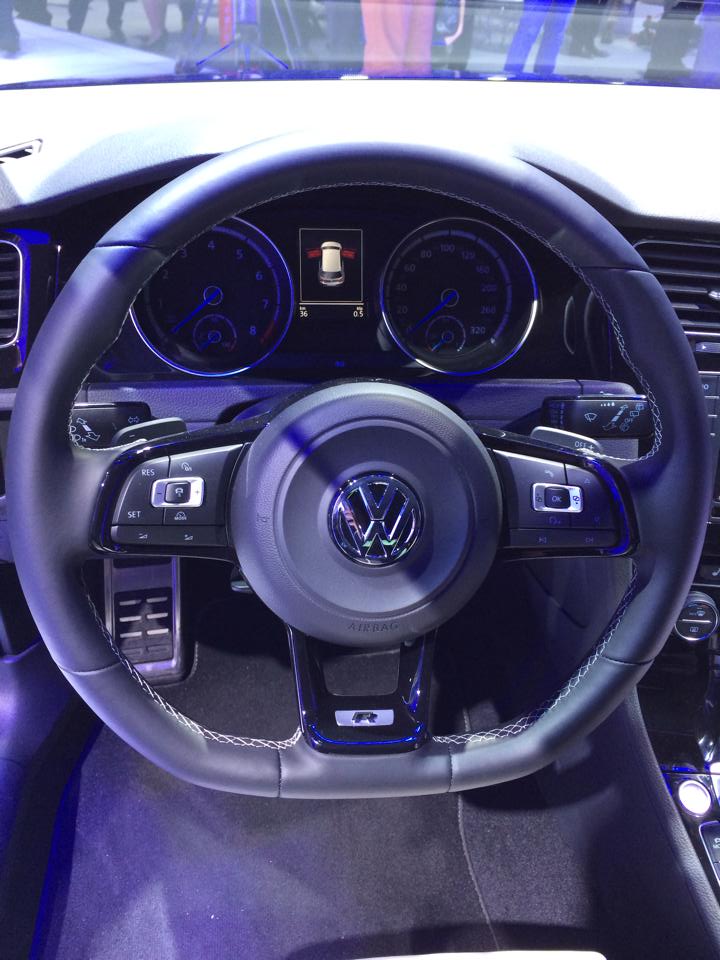 "TrackRatMk1" (trackratmk1)
"TrackRatMk1" (trackratmk1)
01/13/2014 at 14:22 • Filed to: None
 1
1
 7
7
 "TrackRatMk1" (trackratmk1)
"TrackRatMk1" (trackratmk1)
01/13/2014 at 14:22 • Filed to: None |  1 1
|  7 7 |
The turbo-4 wars have lead to engines with a lack of character and fun stifling redlines below 6500prm. But today, straight from the floor at Cobo hall... I'll be damned. This is a noteworthy improvement.

 spanfucker retire bitch
> TrackRatMk1
spanfucker retire bitch
> TrackRatMk1
01/13/2014 at 14:25 |
|
I give VW a lot of flak for their (mostly) uninspired design language and their less than sterling reputation for long-term reliability. But damn if they don't make an awesome steering wheel - in both form and function.
 04sneaky - Boxers. Blowers. Bikes. And bitches.
> TrackRatMk1
04sneaky - Boxers. Blowers. Bikes. And bitches.
> TrackRatMk1
01/13/2014 at 14:28 |
|
Redline and making power at 7500 are two different things.
My Cobra has a redline of 7,200 but stops making power at 6,500-6,600.
I agree that a screaming 4-cylinder near 8k is one of the best sounds on earth regardless if its actually making power or not lol.
 TrackRatMk1
> 04sneaky - Boxers. Blowers. Bikes. And bitches.
TrackRatMk1
> 04sneaky - Boxers. Blowers. Bikes. And bitches.
01/13/2014 at 14:30 |
|
Absolutely. Just in terms of fun factor and engine character, it's nice to know that whatever factors were limiting rpm in blown 4 bangers are changing. I think direct injection was/is a big part of the issue.
 BugEyedBimmer - back in the Saddle Dakota Leather
> TrackRatMk1
BugEyedBimmer - back in the Saddle Dakota Leather
> TrackRatMk1
01/13/2014 at 14:39 |
|
Man those look like Mk4 gauges...
 jlmounce
> TrackRatMk1
jlmounce
> TrackRatMk1
01/13/2014 at 14:42 |
|
I would say it's more characteristic of turbocharging technology. An engines maximum safe rev limit is determined primarily by it's valvetrain as well as the parts used in it's rotating assembly. Turbocharging the engine doesn't change those factors as long as it was designed with the added combustion stresses involved with a boosted application.
Driving a turbocharged 4 will tell you the story. The small displacement make turbo choices somewhat difficult to pin down. For more street applications, you want early spool characteristics that produce useable torque. This usually means that the turbocharger isn't capable of supplying enough air to the engine to run past a certain RPM.
If you go for the opposite and your goal is top end power, you sacrifice driving dynamics and get your typical turbo lag equipped vehicle. Fast when you want it, but otherwise lethargic and uninspired in 98% of driving situations.
Direct injection lets us ramp up on the compression ratio which helps with low end torque production and also helps spool the turbocharger faster. So now we can start putting larger turbos on the same sized engines without seeing those ill-effects.
The final piece is turbocharger technology itself. Multi-scroll turbos with low friction bearings and light weight ceramic impellers have higher rpm tolerances, flow more air and spin up quicker. This all helps the engine behave more like it would without the turbocharger.
The holly grail will be to create an engine/turbocharger application that spools off idle, provides normally aspirated like throttle response with enough volume to still be providing meaningful airflow at upper rpms. Currently the only way to achieve anything close to that is through use of systems like sequential or compound systems that add weight, complexity, heat etc.
 Textured Soy Protein
> TrackRatMk1
Textured Soy Protein
> TrackRatMk1
01/13/2014 at 14:53 |
|
As someone who over the years has on multiple occasions tried and failed to like VW products, I say,
"Hrrrmph."
 TrackRatMk1
> jlmounce
TrackRatMk1
> jlmounce
01/13/2014 at 15:35 |
|
Awesome post. If you are familiar with VW products, the company has typically assigned different turbos for different applications, precisely for the reasons you describe. K03 is a mid-range boost peak, providing early and mid-range torque for cars needing to either haul weight around (CC, Tiguan, etc) or feel gutsy from the moment of throttle tip-in (GTI). K04 is a higher boosting, higher RPM turbo they save for the 2013 Golf R, also on Audi TTS, which are relatively dead below 3000rpm. Twin-scroll turbos are more expensive, but start to give more across the board performance with less drawbacks, and I believe this is what they have gone with on the next Golf R. I mentioned direct injection because I believe the a lot of high pressure injectors were failing at high RPM, so if that problem is now solved, I see no reason why we can't have more high(er) compression turbo motors.